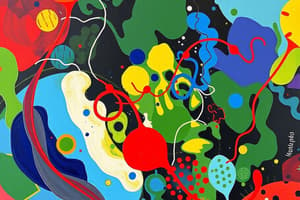Podcast
Questions and Answers
Which molecule acts as an electron carrier in the electron transport chain and can accept one electron to become semiubiquinone radical or two electrons to become ubiquinol?
Which molecule acts as an electron carrier in the electron transport chain and can accept one electron to become semiubiquinone radical or two electrons to become ubiquinol?
- NADH
- CoQ
- Ubiquinone (correct)
- Fe-S centers
What is the function of prosthetic groups in proteins involved in the electron transport chain?
What is the function of prosthetic groups in proteins involved in the electron transport chain?
- Act as cables that conduct electrons (correct)
- Act as enzymes that catalyze reactions
- Act as electric insulators
- Act as structural support
Which molecule is reduced by complex 1 in the electron transport chain?
Which molecule is reduced by complex 1 in the electron transport chain?
- NADH
- CoQ (correct)
- NAD+
- CoQH2
What type of molecule is ubiquinone (Coenzyme Q)?
What type of molecule is ubiquinone (Coenzyme Q)?
What is the role of Fe-S centers in proteins involved in the electron transport chain?
What is the role of Fe-S centers in proteins involved in the electron transport chain?
What happens to ubiquinone when it accepts one electron?
What happens to ubiquinone when it accepts one electron?
What allows ubiquinone to freely diffuse in the lipid bilayer?
What allows ubiquinone to freely diffuse in the lipid bilayer?
What is the function of complex 1 in the electron transport chain? which 2 are correct?
What is the function of complex 1 in the electron transport chain? which 2 are correct?
Flashcards are hidden until you start studying
Study Notes
Electron Carriers and Ubiquinone
- Ubiquinone, also known as Coenzyme Q, acts as an electron carrier in the electron transport chain, able to accept one electron to become semiubiquinone radical or two electrons to form ubiquinol.
- Ubiquinone is a lipid-soluble molecule, enabling its free diffusion within the lipid bilayer of the mitochondrial membrane.
Functions of Prosthetic Groups
- Prosthetic groups are non-polypeptide units that assist in the functionality of proteins, including those in the electron transport chain, by facilitating electron transfer or aiding in the enzymatic activity of the protein.
Complex 1 and Electron Transfer
- Complex 1 of the electron transport chain reduces NAD+ to NADH, playing a crucial role in transferring electrons to ubiquinone, converting it into ubiquinol.
Role of Fe-S Centers
- Iron-sulfur (Fe-S) centers are pivotal in electron transfer within proteins of the electron transport chain, acting as intermediate carriers for electrons between different components of the chain.
Ubiquinone and Electron Acceptance
- When ubiquinone accepts one electron, it transforms into the semiubiquinone radical, which is a key intermediate in the electron transfer process.
Function of Complex 1
- The major functions of complex 1 include catalyzing the transfer of electrons from NADH to ubiquinone and aiding in the pumping of protons across the mitochondrial membrane, contributing to the proton gradient essential for ATP synthesis.
Studying That Suits You
Use AI to generate personalized quizzes and flashcards to suit your learning preferences.




